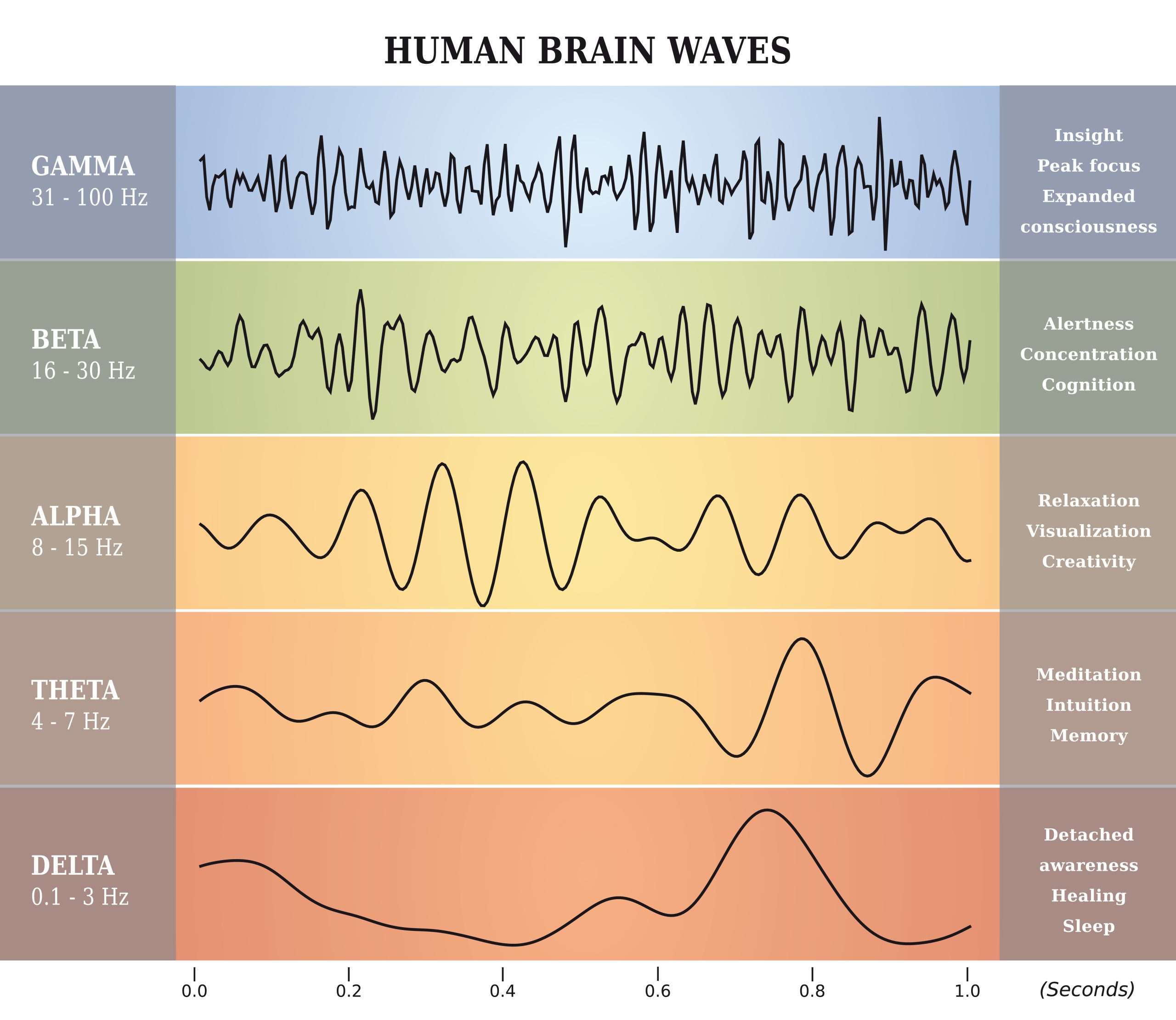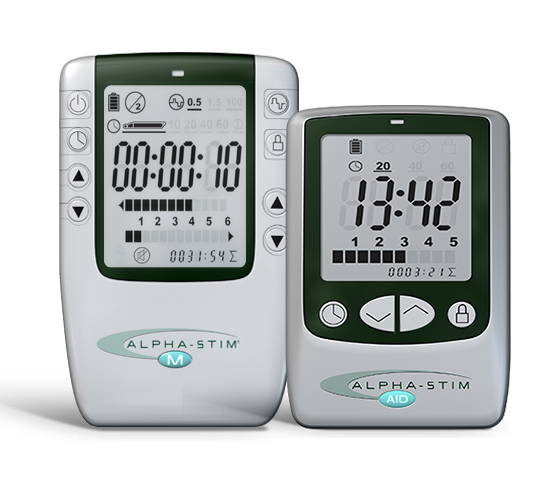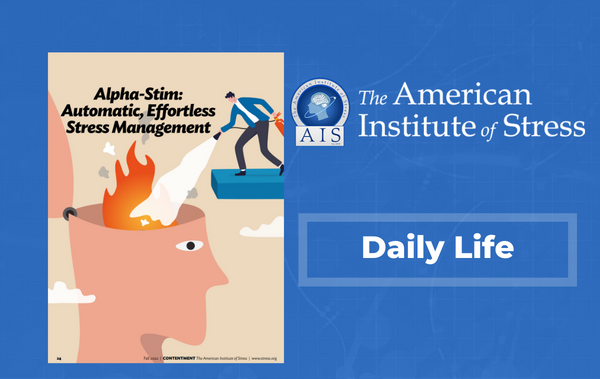
*This is an article from the Fall 2022 issue of Contentment Magazine.
By Josh Briley, PhD, BCMAS, FAIS
A recent Gallup poll found people worldwide are experiencing more stress and unhappiness than ever. This poll found that more than 40% of people worldwide reported experiencing worry or stress in the previous 24 hours.1 Tempting as it may be to blame these findings on the COVID pandemic, inflation, supply chain issues, and the myriad of other crises that flood the news on a daily basis, the Gallup poll “Negative Experience Index” has been climbing steadily since 2014. More people are feeling higher levels of stress and worry each year.
In response to this increase in stress and worry, the stress management industry is booming. Streaming services such as Amazon Prime Video, YouTube, Roku, and Netflix have yoga or mindfulness programs that subscribers can use to guide their efforts to reduce distress. Self-help books continue to be published, with catchy titles such as “UnF*ck Yourself”2 (a great book that I strongly recommend, by the way), or authored by celebrities such as Kevin Hart.3
The devices we wear daily can also be utilized to manage stress. Apple Watches and FitBits monitor heart rate. Apple Watch has a Mindfulness feature to remind users to take a minute to focus on their breathing and shift their attention to the present moment. The number one app in the App Store for several years has been Calm, which teaches meditation and mindfulness techniques in a simple and easy-to-follow manner. New devices seem to be introduced constantly.
These books, apps, and devices are all good resources for teaching someone to improve the way they cope with stress. However, these resources all involve entrainment of the brain to develop novel, more adaptive methods of responding to stress. In other words, they require actively learning stress management techniques to teach yourself better ways of coping with stress. Teaching users how to better cope with and manage stress is a proven and effective approach. However, if you are already feeling overwhelmed, feeling as if there is not enough time in the day, and as if your to-do list is too long, then adding “one more thing,” even a positive task, can feel like just too much effort.
However, there is a device that has been on the market for over four decades, that has a different approach. A device with well over 100 clinical studies, and loads of real-world evidence and testimonials, and has been proven safe, easy, and effective. This device is the Alpha-Stim.® Unlike the apps, books, and devices discussed above, Alpha-Stim automatically balances your nervous system to restore homeostasis and help the user feel calm and relaxed, while at the same time feeling alert and focused. Unlike other devices, Alpha-Stim does not require learning new stress management techniques or involve training your brain to better cope with stress. The effects are effortless and automatic. Before we explore how Alpha-Stim helps to balance the nervous system and restore homeostasis, let’s explore the effects of stress on the nervous system and body.
Physiological Effects of Stress
Stress occurs when the demands of the environment exceed our physical and emotional resources. In other words, anytime we feel threatened, under pressure, or surprised, we experience stress. Stress in and of itself is not a bad thing. Up to a point, stress can have a positive impact on performance, attitude, and development. Without stress, an organism can become stagnant and weak.
Our nervous system has a built-in mechanism for channeling stress in ways that improve our chances of survival. This mechanism is the sympathetic nervous system, also known as the “fight/flight/freeze response.” When the sympathetic nervous system is activated, heart rate, blood pressure, and muscle tension all increase. We develop a perceptual “tunnel vision” to focus on the stressor. Our digestive system slows, allowing more physical resources to be channeled to the heart and limbs, making it easier to escape the stressor or defend ourselves, if necessary.
The sympathetic nervous system is designed to be a temporary response, and once the stressor has passed, the parasympathetic nervous system is designed to activate, reversing the physiological effects of the sympathetic nervous system. For this reason, the parasympathetic nervous system has been termed the “rest and digest response.” When the parasympathetic nervous system is activated, our blood pressure, heart rate, breathing, and muscle tension all return to normal. Vital functions, such as digestion, return to normal and are given physiological priority again. Heart rate variability (a measure of how quickly we recover from stress and a good overall measure of fitness) improves as well.
The sympathetic nervous system is an “all-or-nothing” response. It does not give a weaker response if the stressor is less than life threatening. The response is the same whether the stressor is nearly being hit head on when driving, or the stressor is less life-threatening, such as being late for an appointment and getting stuck at a traffic light. The result of modern society is the sympathetic nervous system is “stuck” on activation, and the parasympathetic nervous system is chronically underactive. Due to this chronic imbalance between the sympathetic and parasympathetic nervous systems, we experience fatigue, difficulty with concentration and memory, and feeling overwhelmed or “on-edge” most of the time. Physiologically, we experience high blood pressure, low heart rate variability, rapid and shallow breathing, digestive problems, muscle tension and pain. We have difficulty sleeping due to racing thoughts, ruminating on all the problems of the past. Of course, these very effects of our chronically overactive sympathetic nervous system themselves become a trigger for increased feelings of stress, which contributes to a vicious cycle upon which our stress levels continue to escalate due to the physiological and emotional responses to feeling stressed.
A Brief Word on the Electrochemical Nature of the Nervous System
The nervous system is electrochemical. Electrical charges travel from the dendrites, along the axon (the “body” of the nerve cell) to the axon terminals. When this charge reaches the axon terminals, neurotransmitters and other chemicals are released into a small gap between nerve cells, called the “synapse.” These chemicals cross the synapse to activate receptors in the dendrites of the nerve cell on the other side of the synapse. As these receptors are activated, an electrical charge begins to build. Once this charge reaches the necessary threshold, the nerve cell fires, and the electrical charge is carried along the body of that cell to the next synapse.
We use substances and chemicals to influence the actions of the receptors on our nerve cells. For example, caffeine, the most used and misused central nervous system stimulant, acts to increase the activity of the central nervous system by, among other effects, activating the neurotransmitters noradrenaline and serotonin, producing temporary feelings of alertness and energy. The increase in these chemicals speed up the activity of nerve cells in the central nervous system. Medications also attempt to chemically influence nerve cell activity by binding with nerve cell receptors to either block neurotransmitters from activating the receptor, or by activating the receptors themselves.
The receptors in the nervous system can also be activated with an electrical frequency. Nerve cell receptors are tuned to specific frequencies, and when the frequency a receptor is tuned to approaches, then the receptor is activated and acts upon the cell as it would if that receptor was activated by a chemical, such as a medication molecule or a neurotransmitter. When a variety of frequencies are transmitted to the nervous system, receptors are activated only by the frequencies they are tuned to, and all others are ignored. The transmission of multiple frequencies to the nervous system allows the nerve cell receptors to “pick and choose” the frequencies needed to restore balance to the nervous system.
Another electrical aspect of the central nervous system is brain waves, electrical waves at different frequencies that influence, and are influenced by, the functioning of the nervous system. Delta waves, at a slow frequency of 0.1 to 3 Hz, are associated with sleep, drowsiness, and detached awareness. Theta waves (4 – 7 Hz) are prominent during meditation and are also associated with intuition and memory. Alpha waves (8 – 15 Hz) are associated with feeling relaxed and calm (commonly referred to as an “alpha state”) as well as creativity. Beta waves (16 – 30 Hz) are prominent during periods of alertness, concentration, and problem-solving. Finally, Gamma waves (31 – 100 Hz) are associated with peak focus, expanded consciousness, and insight.
Activity in the different brain wave frequencies influences how we feel. For example, when we are sleepy and drowsy, or in deep sleep, there is more activity in the delta wave frequencies. When we are alert, concentrating, and focused, the gamma wave frequencies are more active. However, we can also influence our brain wave activity by our activities and efforts. By learning to relax, for example through meditation, yoga, mindfulness exercises, we increase the activity in the alpha wave frequencies, which facilitates the “alpha state” feeling of being calm, relaxed. During this state, our heart rate variability (HRV) improves, muscle tension decreases, breathing becomes slower and steadier, and we feel at ease and at peace.
Traditional Stress Management Techniques
As mentioned at the beginning of this article, people are more stressed and worried than any time in recorded history. This increase has been occurring for almost a decade and is occurring despite the rise in self-help resources such as apps, devices, and services available at our fingertips. These resources are all very effective in teaching methods of reducing and more effectively coping with stress. Essentially, these resources, using their own specific approaches, whether they overtly state it or not, are teaching their clients to switch out of the “fight/flight/freeze” response of sympathetic nervous system activation and into the “rest and digest” mode of parasympathetic nervous system activation. Additionally, they are helping users to increase alpha wave activity to bolster that sense of relaxation and tranquility.
 So, if these resources are so readily available and effective, then why are we, as a whole, not taking advantage of the very resources that will help reduce our ever-increasing stress levels? It is not because we do not know such resources are available, nor is it because we do not think we have a problem. Talk to almost anyone about how they are feeling, and if it is a genuine, honest conversation; they will admit to feeling stressed and overwhelmed and knowing they need to engage in relaxation exercises, meditation, or mindfulness more often. However, the very feeling of being overwhelmed and not having enough time in the day to accomplish everything they must do decreases the chances of engaging in these activities that will help reduce the stress levels we know are too high.
So, if these resources are so readily available and effective, then why are we, as a whole, not taking advantage of the very resources that will help reduce our ever-increasing stress levels? It is not because we do not know such resources are available, nor is it because we do not think we have a problem. Talk to almost anyone about how they are feeling, and if it is a genuine, honest conversation; they will admit to feeling stressed and overwhelmed and knowing they need to engage in relaxation exercises, meditation, or mindfulness more often. However, the very feeling of being overwhelmed and not having enough time in the day to accomplish everything they must do decreases the chances of engaging in these activities that will help reduce the stress levels we know are too high.
Additionally, while very effective, as with any other skill, learning the techniques taught by traditional stress management techniques requires practice to ensure efficacy. For the overwhelmed and busy, adding a new daily task they must find time to practice makes it less likely that skill will be learned efficiently enough to be effective when needed.
Alpha-Stim: A Different Approach

©EPI – Used with permission
In contrast, Alpha-Stim Cranial Electrotherapy Stimulation (CES) utilizes a patented waveform to transmit a variety of electrical frequencies into the central nervous system. These frequencies help to calm down cells that are hyperactive, while simultaneously stimulating activity in cells that are underactive. The electrical current is transmitted across the brain via the use of electrodes that clip onto the earlobes.
Once these frequencies enter the nervous system, many changes occur within the brain. There are effects to the adrenaline, serotonin, and cortisol pathways. There are immediate brainwave changes that can be measured by an EEG. The most notable change in brain wave activity is the induction of an alpha state, which is a range of alpha brain wave activity associated with feeling relaxed and calm. It is the same brain wave activity that can be observed by people who practice meditation regularly. In addition, there are changes to delta wave activity, especially in the frontal lobe right behind the eyes and forehead. Delta waves are associated with feelings of drowsiness and sleep. In general, an Alpha-Stim treatment results in an increase in alpha wave activity and a decrease in delta wave activity,4 leaving the user feeling calm and relaxed, while at the same time alert and focused (See Figure 2).
 ©EPI – Used with permission
©EPI – Used with permission
An Alpha-Stim treatment also activates the parasympathetic nervous system, which as described above results in improved heart rate variability, improved digestive functioning, and improved ability to relax. Khyatee et al., found that Alpha-Stim treatment significantly improved heart rate variability in patients with hypertension and with insomnia.5,6 In studies of situational anxiety, a form of stress that occurs in response to a specific anticipated stressor (such as a dental appointment or public speaking), Alpha-Stim has shown to decrease not only subjective feelings of stress, but also the physical symptoms of muscle tension, pulse rate, and skin temperature (See Figure 3).7 Therefore, Alpha-Stim is a very effective tool for stress management.

©EPI – Used with permission
Unlike the traditional stress management tools mentioned in this article, Alpha-Stim works automatically, no practice or entrainment needed. The device is portable, approximately the size of a cell phone, and designed to be used at home at a time that is convenient for the user. The patented waveform automatically induces an alpha state, leaving the user feeling calm and relaxed after just a single treatment. However, the results are also cumulative, meaning the more days you use an Alpha-Stim, the better the results will be and the longer they will last.
While Alpha-Stim works well if one is relaxing during use, such as reading a book, watching TV, or meditating, it also works extremely well if used while the person is actively engaged in their normal activities. As many of my coworkers do, I use my Alpha-Stim in my office while working on my computer, answering phones, or attending meetings. I know people who use their Alpha-Stim during light to moderate exercise, such as going for a walk outside or on a treadmill. Driving or operating heavy machinery is the only activity that is discouraged during an Alpha-Stim treatment.
In the U.S., Alpha-Stim requires the order of a licensed provider before a patient can purchase one, but in some countries, it can be purchased over the counter. The instructions for using an Alpha-Stim are quite simple and easily accessible. At the end of the treatment, the user should feel light and relaxed. Most people will use an Alpha-Stim at least once daily for three to six weeks, and then begin to decrease use to every other day, twice a week, or as needed, though many people continue to use their Alpha-Stim daily.
Alpha-Stim is Safe
The safety of Alpha-Stim has been established in over 41 years on the market and well over 100 clinical trials. Alpha-Stim has been shown to be safe and effective with users of all ages. Unlike with medications and other medical stimulation devices, there is no risk of addiction. Side effects, which are extremely rare, mild, and self-limiting, occur 0.11% of the time over the past 10 years. The commonly reported side effects are a mild headache or dizziness, which are generally an indication the current being used is slightly too high for that treatment session and can be resolved by putting the earclips back on, turning the current down from what was used in the treatment session, and treating until two minutes after the headache or dizziness subsides (usually just a few minutes). Skin irritation, especially in people with fair skin, is the next most commonly reported side effect, occurring 0.07% of the time. It generally clears on its own, but some over the counter skin ointment can be used if desired. As with most other medical devices or medications, the safety of using an Alpha-Stim while pregnant has not been established in clinical research. The only contraindication to using an Alpha-Stim is the presence of an implanted electrical device that cannot be turned off, such as a pacemaker, a defribilator, or a cochlear implant.
Summary
On the whole, we are more stressed and worried than any point in history, and getting worse each year. The most commonly used stress management techniques require additional effort and time set aside to practice in order for them to become effective. Scheduling this time and putting forth this effort can seem overwhelming to a person who is already experiencing high levels of stress and worry. In contrast, Alpha-Stim can be used during the normal course of our daily schedules, without disrupting our routines or requiring us to practice and learn new skills and techniques. This safe and easy to use device automatically induces an alpha state and activates the parasympathetic nervous system, which results in feeling relaxed and calm. You can learn more at www.alpha-stim.com.
References
- Ray, J. (June 28, 2022). World Unhappier, More Stressed Out than Ever. https://news.gallup.com/poll/394025/world-unhappier-stressed-ever.aspx, Accessed July 23, 2022
- Kennerly, R. QEEG analysis of Cranial Electrotherapy: A Pilot Study. Journal of Neurotherapy, (8)2, 2004. Presented at the International Society for Neuronal Regulation conference, September 18-21, 2003, Houston, Texas
- Khyatee, S., Sarker, A., & Aggarwal, R. (2019). Impact of Cranial Electrotherapy Stimulation Based Analysis of Heart Rate Variability in Insomnia. In: Prateek M., Sharma D., Tiwari R., Sharma R., Kumar K., Kumar N. (eds) Next Generation Computing Technologies on Computational Intelligence. NGCT 2018. Communications in Computer and Information Science, Vol 922. Springer, Singapore.
- Khyatee, S., Sarker, A., Aggarwal, R., & Singh, R. (2020). Impact of Cranial Electrotherapy Stimulation on Statistical Indices of Time Domain Parameters of Heart Rate Variability in Hypertensive Individuals. Indian Journal of Public Health Research & Development, 11(3), 157-163.
- Heffernan, M. The Effect of a Single Cranial Electrotherapy Stimulation on Multiple Stress Measures. The Townsend Letter for Doctors. 147:60-64, 1995. Presented at the Eighth International Montreux Congress on Stress, Montreux, Switzerland, February 1996.
ABOUT THE AUTHOR
 Josh Briley, PhD, BCMAS, FAIS is the Clinical Education Director for Electromedical Products International, Inc., the manufacturer and distributor of Alpha-Stim devices. Dr. Briley is a licensed clinical psychologist. He has worked for the Federal Bureau of Prisons, the Veterans Health Administration, owned a private practice, and taught online courses for undergraduate and graduate students. He currently serves on the Daily Life and Workplace Stress board for the American Institute of Stress.
Josh Briley, PhD, BCMAS, FAIS is the Clinical Education Director for Electromedical Products International, Inc., the manufacturer and distributor of Alpha-Stim devices. Dr. Briley is a licensed clinical psychologist. He has worked for the Federal Bureau of Prisons, the Veterans Health Administration, owned a private practice, and taught online courses for undergraduate and graduate students. He currently serves on the Daily Life and Workplace Stress board for the American Institute of Stress.
Contentment Magazine
The dictionary defines “content” as being in a state of peaceful happiness. The AIS magazine is called Contentment because we want all of our guests and members to find contentment in their lives by learning about stress management and finding what works best for each them. Stress is unavoidable, and comes in many shapes and sizes that makes being in a state of peaceful happiness seem like a very lofty goal. But happiness is easy to find once you are able to find ways to manage your stress and keep a healthy perspective when going though difficult times in life. You will always have stress, but stress does not always have you!

